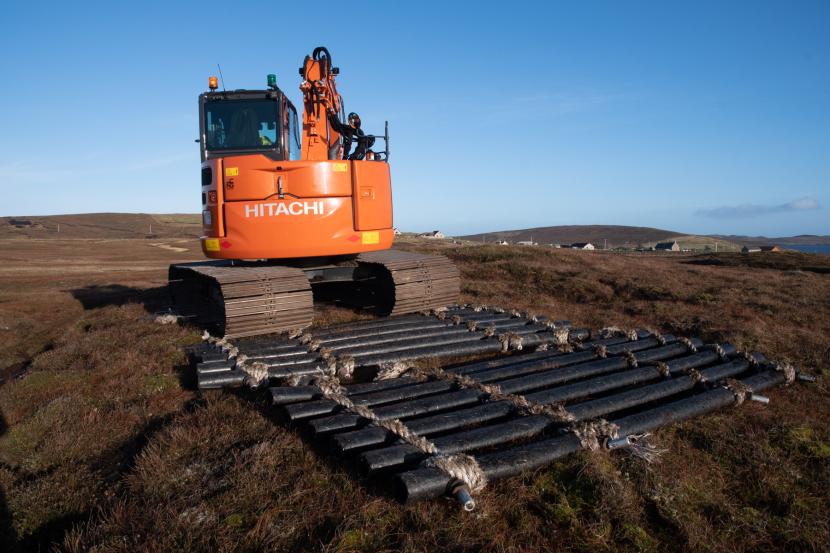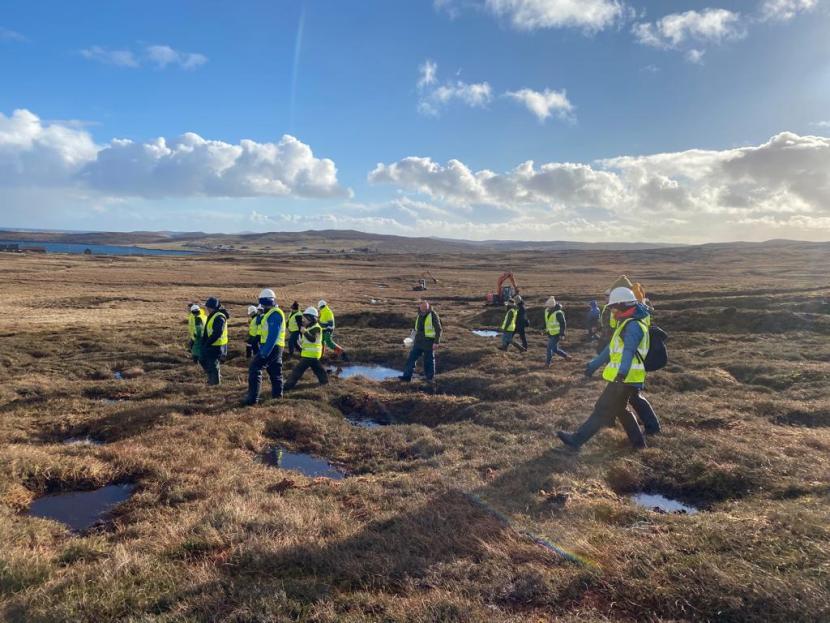
Peatland ACTION case study: What's the connection between peat and innovation?
(Taits Park and Lochend, Shetland)
Peatland ACTION case study: What's the connection between peat and Taits Park and Lochend?
The answer lies in innovation and ingenuity.
Taits Park and Lochend, Shetland
These two projects on a Shetland crofter’s land overcame difficult conditions with innovation and ingenuity. As a result a new peatland restoration business is now going from strength to strength, and the peatlands are on the road to recovery.
Taits Park and Lochend - On the road to restoration
Taits Park is a 100ha owner-occupied apportionment between Girlsta and Loch of Strom on Shetland, with Lochend adjacent to it to the south and west. These sites are very typical of a lot of peat-covered hills along the spine of Shetland mainland. They have been badly damaged by wind and rain, but also by centuries of peat cutting. On an island of few trees peat was often the only option for fuel.
Crofter and businessman Steve Johnson was inspired to carry out the restoration work after his son came back from volunteering with Shetland Amenity Trust on a peatland project, and told him what he’d learnt about how important restoration is in tackling the climate emergency.
Steve approached Shetland Amenity Trust's Peatland ACTION project officer Sue White, and successfully applied for NatureScot Peatland ACTION funding to carry out the restoration work, first at Tait’s Park, and then at Lochend.

This peatland restoration project was funded by NatureScot Peatland ACTION.
Many people took the peat bus to get out to cut their fuel - showing just how extensive this practice was on Shetland © Shetland Museum.
Taits Park and Lochend - Challenges and benefits
The works on the ground were carried out by local contractors new to the peatland restoration sector. It wasn’t an easy introduction. Densely packed erosion gullies and areas of extremely soft peat made access to the sites challenging, especially with the three 8-10 tonne excavators that were needed. Even the commercially sourced matting they bought wasn’t up to the job.
However the contractors’ creative thinking and ingenuity solved the problem. They sourced waste plastic tubing from the local fishing industry’s old salmon cages, and used them to construct strong, lightweight rafts which did the job perfectly. These allowed them to move across the site safely with minimum damage to the peat.

This peatland restoration project was funded by NatureScot Peatland ACTION.
© Austin Taylor.
Because of these difficulties, which slowed progress significantly, additional funding was agreed for a second season of work. This highlights Peatland ACTION’s flexible approach, which takes into account the fact that peatland restoration is carried out in remote areas in challenging conditions, which can sometimes impact the even the best-laid plans.
The combination of the dense network of erosion gullies and the poor sphagnum coverage on the tops of the hags also made work difficult, as there was limited suitable vegetation onsite for reprofiling, while a particularly cold winter caused some of the turves that were used to die back before they had chance to get established.
A number of different revegetation techniques were tried, including hydroseeding and plug plants, but the most successful were using locally harvested mulch and clump planting of sphagnum. The contractors also tried a novel technique – using waste salmon smolt nets as a geotextile – to help stabilise the areas of bare peat. This had been trialled on a smaller scale project, and proved a good alternative to commercially available geotextiles, creating a new use for an otherwise redundant material.
In the end, across the two sites, over 100,000m of gullies were dammed and reprofiled, while over 12ha of bare peat were revegetated. In total 122 ha of damaged peatland has been put on the road to recovery.
Taits Park and Lochend - Successful outcomes
It was the original success of Taits Park that encouraged Steve to carry out further restoration work at Lochend, and this has also inspired at least two other local apportionments to apply for Peatland ACTION funding.
Sue White supported Steve throughout the whole restoration process, helping him with the application, carrying out the necessary pre-restoration surveys, and working with him to project manage the restoration itself.

This peatland restoration project was funded by NatureScot Peatland ACTION.
Peatland ACTION project officer Sue White and volunteer Kate Humble clump planting sphagnum moss. © Jon Dunn
In addition, the work gave the contractors the opportunity to increase their peatland skills, and they have now set up a new specialist restoration business on Shetland.
Steve and his father Magnie also took part in a pilot study funded through the NatureScot-led Piloting an Outcomes Based Approach in Scotland (POBAS) scheme. This involved 40 farmers and crofters in four clusters testing innovative approaches to delivering better environmental outcomes on farms and crofts across Scotland. Steve’s study looked at how effective ‘NoFence’ collars on cattle would be in allowing them to graze sites where peatland restoration has taken place. The results were very positive, with the collars allowing cattle to access valuable grazing without damaging any sensitive or recovering peatland areas. The collars also made it easier to find the cattle on the hill as the crofter could locate them on the NoFence phone app.
This peatland restoration project was funded by NatureScot Peatland ACTION.
The cattle with their NoFence collars. © Magnie Johnson
Steve is now an enthusiastic advocate for peatlands. He has supported a number of demonstration and volunteering events organised by SAT on the sites. Easy access from the road means they are ideal for this kind of activity, and in 2022 alone over 120 people visited Lochend with the Peatland ACTION project officer Sue White.

This peatland restoration project was funded by NatureScot Peatland ACTION.
One of the very popular demonstration days held at Lochend. © Sandy Middleton
For further information, or to get involved with PeatlandACTION
We want to build on our restoration efforts to create a healthier peatland landscape for people and nature.
- We offer funding for suitable peatland restoration projects across Scotland;
- We offer, where appropriate, multi-year funding;
- We fund up to 100% of the capital costs;
- We fund much of the pre-application work, for example, peat depth surveys and feasibility studies.
- We have officers who can help design your project, offer advice on restoration management and assist you to complete your application and supporting information.
Peatland ACTION case studies: We demonstrate links between peat condition and: fisheries; grouse; carbon storage; wildlife; landscapes; human history; and so much more.
If you would like to contribute to the on-going work of Peatland ACTION please contact [email protected].
For further information: www.nature.scot/peatlandaction.





